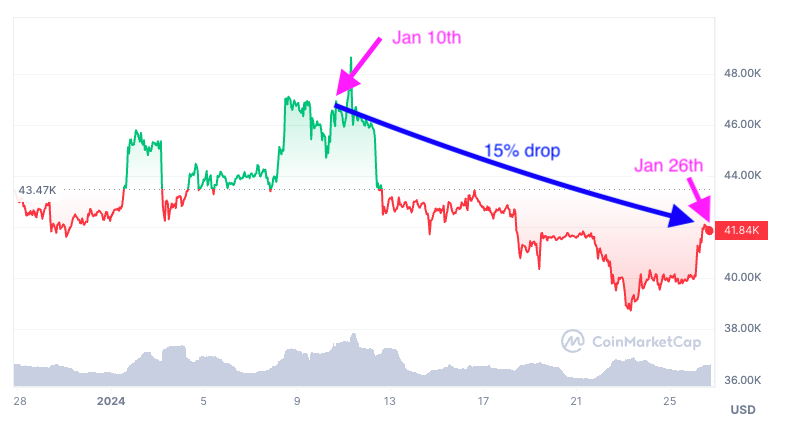- Despite high expectations, the launch of spot bitcoin ETFs coincided with a 15% drop in bitcoin’s price, partly due to substantial outflows from GBTC as it transitioned into an ETF, allowing investors to withdraw their capital.
- Market sentiment around bitcoin is mixed, with some predicting further price declines and noting a lack of significant positive advancements, despite new product innovations and the upcoming bitcoin halving.
By Daniel Kuhn
By nearly all metrics, spot bitcoin ETFs have been off to a great start. And yet, the launch of these much anticipated products is tanking the price of the industry’s leading asset. Since Jan. 10, the day the U.S. Securities and Exchange Commission (SEC) approved the roster of exchange-traded funds, bitcoin (BTC) is down about 15%.
What was widely regarded to be the most bullish event in recent crypto history, with the possibility of drawing in millions of new bitcoin investors and potentially billions in capital, may actually — at least temporarily — be cooling bitcoin’s jets.
This is largely due to the billions of dollars exiting GBTC, which transitioned to an ETF from a closed-ended trust, meaning investors are finally able to pull their capital out. Grayscale has seen more than $3 billion in redemptions, only some of which is flowing into other bitcoin ETFs that charge much lower fees than GBTC’s 1.5%.

On social media, noted VC Chris Burniske said bitcoin has yet to bottom out, giving a price prediction as low as $20,000, in an echo of a recent Deutsche Bank survey that found one-in-three respondents saying the largest cryptocurrency could dip below $20,000 by year’s end.
Just 15% of Deutsche’s 2,000 survey takers across the U.S., U.K. and E.U. said they expect bitcoin’s price to stabilize between $40,000 and $75,000 by year-end.
Is this negative sentiment around bitcoin warranted? Burniske apparently doesn’t see many positive advancements in the near term, not even mentioning the upcoming bitcoin halving (expected in April) that many other market onlookers are hoping will buoy bitcoin.
“New product innovations are close, but not quite there yet … things still feel insular,” Burniske wrote, adding that “precarious” macroeconomic factors will likely continue to press on bitcoin.
It’s hard to say exactly what will happen, but it’s also difficult to see many long-term headwinds working against bitcoin. In terms of regulation, it seems like the worst of it is behind the industry now that Binance settled charges with the Department of Justice and the FTX saga is wrapped up.
And if it’s true that continuing outflows from GBTC are primarily the cause of the recent market dip, that’s likely to wrap up eventually, too. FTX, for instance, has already sold off all of its GBTC. Many others participated in the so-called “widowmaker trade,” which involved trading BTC for GBTC and profiting when GBTC was at a premium and losing big when it fell to a discount, but JPMorgan said “GBTC profit taking” is likely over.
But to put recent downward price movements in context, bitcoin fell nearly 30% the day the SEC rejected the first bitcoin ETF application submitted by Cameron and Tyler Winklevoss in 2013. Then, there’s the bull market beginning in 2017, a year which began with the People’s Bank of China deciding to ban crypto and restricting what were then the “Big Three” exchanges, Huobi, OKCoin and BTCC.
All of this is to say that bitcoin has always had its ups and downs. Bitcoin ETFs have been a disappointment in terms of immediately fomenting another rally, but are still a symbol for the long-term viability of the asset class. The first few weeks of trading have seen record-busting volumes, and as Deutsche’s survey found the majority of ETF flows have come from retail investors, indicating it is a tool that could further adoption.
As Burniske said, “As always, patience is your friend.”
See source article HERE
Disclaimer: The information provided on this page does not constitute investment advice, financial advice, trading advice, or any other sort of advice and it should not be treated as such. This content is the opinion of a third party and this site does not recommend that any specific cryptocurrency should be bought, sold, or held, or that any crypto investment should be made. The Crypto market is high risk, with high-risk and unproven projects. Readers should do their own research and consult a professional financial advisor before making any investment decisions.

